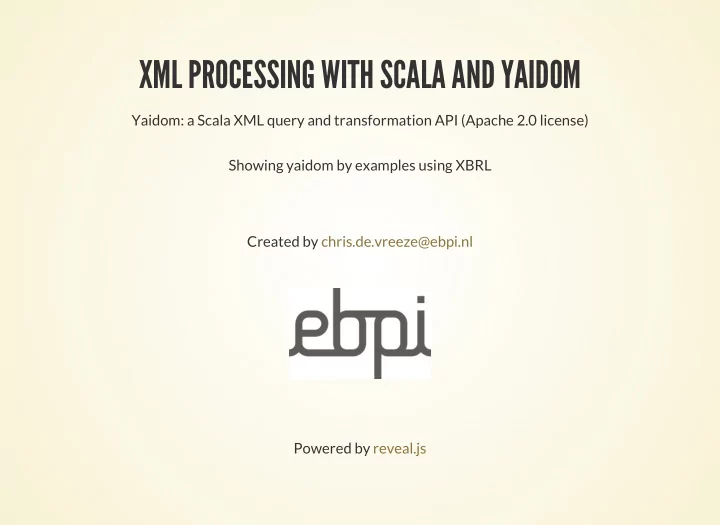

XML PROCESSING WITH SCALA AND YAIDOM Yaidom: a Scala XML query and transformation API (Apache 2.0 license) Showing yaidom by examples using XBRL Created by chris.de.vreeze@ebpi.nl Powered by reveal.js
OVERVIEW OF THE PRESENTATION What is yaidom? Use case: XBRL Introducing Scala higher-order functions Introducing yaidom higher-order functions Namespace validation example XBRL context validation example XBRL context validation example, revisited Takeaway points about yaidom
WHAT IS YAIDOM? An (open source) XML query and transformation API Leverages Scala and the Scala Collections API Defines some core concepts (ENames, QNames, Scope etc.) Its namespace support is built on these concepts Its XML query API is built on its namespace support The same query API is offered by multiple element implementations (why? e.g. XML diff vs. XML editor) Including your own custom ones (easy to add) Including type-safe ones for specific XML dialects (e.g. XBRL)
USE CASE: XBRL Yaidom is shown using the XBRL example below XBRL is an XML-based (financial) reporting standard It is very XML-intensive A business report in XBRL is called an XBRL instance It reports facts Having contexts ("who", "when" etc.) And possibly units ("which currency", etc.)
<xbrli:xbrl xmlns:xbrli="http://www.xbrl.org/2003/instance" xmlns:cc2-i="cc2i" xmlns:cc-t="cct" xmlns:cd="nlcd" xmlns:iso4217="iso4217"> <xbrli:context id="FY14d"> <xbrli:entity> <xbrli:identifier scheme="http://www.cc.eu/cc-id">30267975 </xbrli:identifier> </xbrli:entity> <xbrli:period> <xbrli:startDate>2014-01-01</xbrli:startDate> <xbrli:endDate>2014-12-31</xbrli:endDate> </xbrli:period> </xbrli:context> <xbrli:unit id="EUR"> <xbrli:measure>iso4217:EUR</xbrli:measure> </xbrli:unit> <cc2-i:Equity contextRef="FY14d" unitRef="EUR" decimals="INF">95000</cc2-i:Equity> <cc-t:EntityAddressPresentation> <cd:POBoxNumber contextRef="FY14d">2312</cd:POBoxNumber> <cd:PostalCodeNL contextRef="FY14d">2501CD</cd:PostalCodeNL> <cd:PlaceOfResidenceNL contextRef="FY14d">Den Haag </cd:PlaceOfResidenceNL> <cd:CountryName contextRef="FY14d">Nederland</cd:CountryName> </cc-t:EntityAddressPresentation> </xbrli:xbrl>
INTRODUCING SCALA HIGHER-ORDER FUNCTIONS Scala has a rich Collections API The most commonly used collections are immutable Typically, collections are created from other collections by applying ("for-each-like") higher-order functions For example, function filter takes an element predicate, and keeps only those elements for which the predicate holds And method map takes a function, and replaces all elements by the result of applying the function
First some yaidom basics: Method findAllChildElems finds all child elements EName stands for "expanded name" Below methods "filter" and "map" are shown: val xbrliNs = "http://www.xbrl.org/2003/instance" val contexts = instance.findAllChildElems.filter(e => e.resolvedName == EName(xbrliNs, "context")) val contextIds = contexts.map(e => e.attribute(EName("id")))
INTRODUCING YAIDOM HIGHER-ORDER FUNCTIONS Yaidom's query API offers many higher-order element methods that take an element predicate Most of these functions return a collection of elements E.g., method filterChildElems filters child elements Method filterElems filters descendant elements And method filterElemsOrSelf filters descendant-or-self elements They are somewhat similar to XPath axes, but return only elements If you understand these filtering methods, you understand them all Let's use them to find contexts, units and facts
<xbrli:xbrl xmlns:xbrli="http://www.xbrl.org/2003/instance" xmlns:cc2-i="cc2i" xmlns:cc-t="cct" xmlns:cd="nlcd" xmlns:iso4217="iso4217"> <xbrli:context id="FY14d"> <xbrli:entity> <xbrli:identifier scheme="http://www.cc.eu/cc-id">30267975 </xbrli:identifier> </xbrli:entity> <xbrli:period> <xbrli:startDate>2014-01-01</xbrli:startDate> <xbrli:endDate>2014-12-31</xbrli:endDate> </xbrli:period> </xbrli:context> <xbrli:unit id="EUR"> <xbrli:measure>iso4217:EUR</xbrli:measure> </xbrli:unit> <cc2-i:Equity contextRef="FY14d" unitRef="EUR" decimals="INF">95000</cc2-i:Equity> <cc-t:EntityAddressPresentation> <cd:POBoxNumber contextRef="FY14d">2312</cd:POBoxNumber> <cd:PostalCodeNL contextRef="FY14d">2501CD</cd:PostalCodeNL> <cd:PlaceOfResidenceNL contextRef="FY14d">Den Haag </cd:PlaceOfResidenceNL> <cd:CountryName contextRef="FY14d">Nederland</cd:CountryName> </cc-t:EntityAddressPresentation> </xbrli:xbrl>
Finding facts, contexts and units (as plain XML elements), regardless of the element implementation: val ns = "http://www.xbrl.org/2003/instance" val linkNs = "http://www.xbrl.org/2003/linkbase" def hasCustomNs(e: Elem): Boolean = { !Set(Option(ns), Option(linkNs)).contains( e.resolvedName.namespaceUriOption) } val contexts = xbrlInstance.filterChildElems(withEName(ns, "context")) val units = xbrlInstance.filterChildElems(withEName(ns, "unit")) val topLevelFacts = xbrlInstance.filterChildElems(e => hasCustomNs(e)) val nestedFacts = topLevelFacts.flatMap(_.filterElems(e => hasCustomNs(e))) val allFacts = topLevelFacts.flatMap(_.filterElemsOrSelf(e => hasCustomNs(e)))
Non-trivial queries combine facts with their contexts and units: val contextsById = contexts.groupBy(_.attribute(EName("id"))) val unitsById = units.groupBy(_.attribute(EName("id"))) // Use these Maps to look up contexts and units from // (item) facts, with predictable performance ...
NAMESPACE VALIDATION EXAMPLE To illustrate (low level) validations, let's check the use of "standard" namespaces In particular, let's validate rule 2.1.5 of the international FRIS standard The rule states that some commonly used namespaces should use their "preferred" prefixes in XBRL instances We also check the reverse, namely that those prefixes map to the expected namespaces For simplicity, assume that all namespace declarations are only in the root element
<xbrli:xbrl xmlns:xbrli="http://www.xbrl.org/2003/instance" xmlns:cc2-i="cc2i" xmlns:cc-t="cct" xmlns:cd="nlcd" xmlns:iso4217="iso4217"> <xbrli:context id="FY14d"> <xbrli:entity> <xbrli:identifier scheme="http://www.cc.eu/cc-id">30267975 </xbrli:identifier> </xbrli:entity> <xbrli:period> <xbrli:startDate>2014-01-01</xbrli:startDate> <xbrli:endDate>2014-12-31</xbrli:endDate> </xbrli:period> </xbrli:context> <xbrli:unit id="EUR"> <xbrli:measure>iso4217:EUR</xbrli:measure> </xbrli:unit> <cc2-i:Equity contextRef="FY14d" unitRef="EUR" decimals="INF">95000</cc2-i:Equity> <cc-t:EntityAddressPresentation> <cd:POBoxNumber contextRef="FY14d">2312</cd:POBoxNumber> <cd:PostalCodeNL contextRef="FY14d">2501CD</cd:PostalCodeNL> <cd:PlaceOfResidenceNL contextRef="FY14d">Den Haag </cd:PlaceOfResidenceNL> <cd:CountryName contextRef="FY14d">Nederland</cd:CountryName> </cc-t:EntityAddressPresentation> </xbrli:xbrl>
// All namespace declarations must be in the root element require( xbrlInstance.findAllElems.forall(_.scope == xbrlInstance.scope)) val standardScope = Scope.from( "xbrli" > "http://www.xbrl.org/2003/instance", "xlink" > "http://www.w3.org/1999/xlink", "link" > "http://www.xbrl.org/2003/linkbase", "xsi" > "http://www.w3.org/2001/XMLSchemainstance", "iso4217" > "http://www.xbrl.org/2003/iso4217") val standardPrefixes = standardScope.keySet val standardNamespaceUris = standardScope.inverse.keySet val subscope = xbrlInstance.scope.withoutDefaultNamespace filter { case (pref, ns) => standardPrefixes.contains(pref) || standardNamespaceUris.contains(ns) } require(subscope.subScopeOf(standardScope)) // fails on iso4217
XBRL CONTEXT VALIDATION EXAMPLE Let's now validate rule 2.4.2 of the international FRIS standard The rule states that all contexts must be used We also check the reverse, that all context references indeed refer to existing contexts N.B. The latter check belongs to XBRL instance validation, not to FRIS validation for XBRL-valid instances
Recommend
More recommend